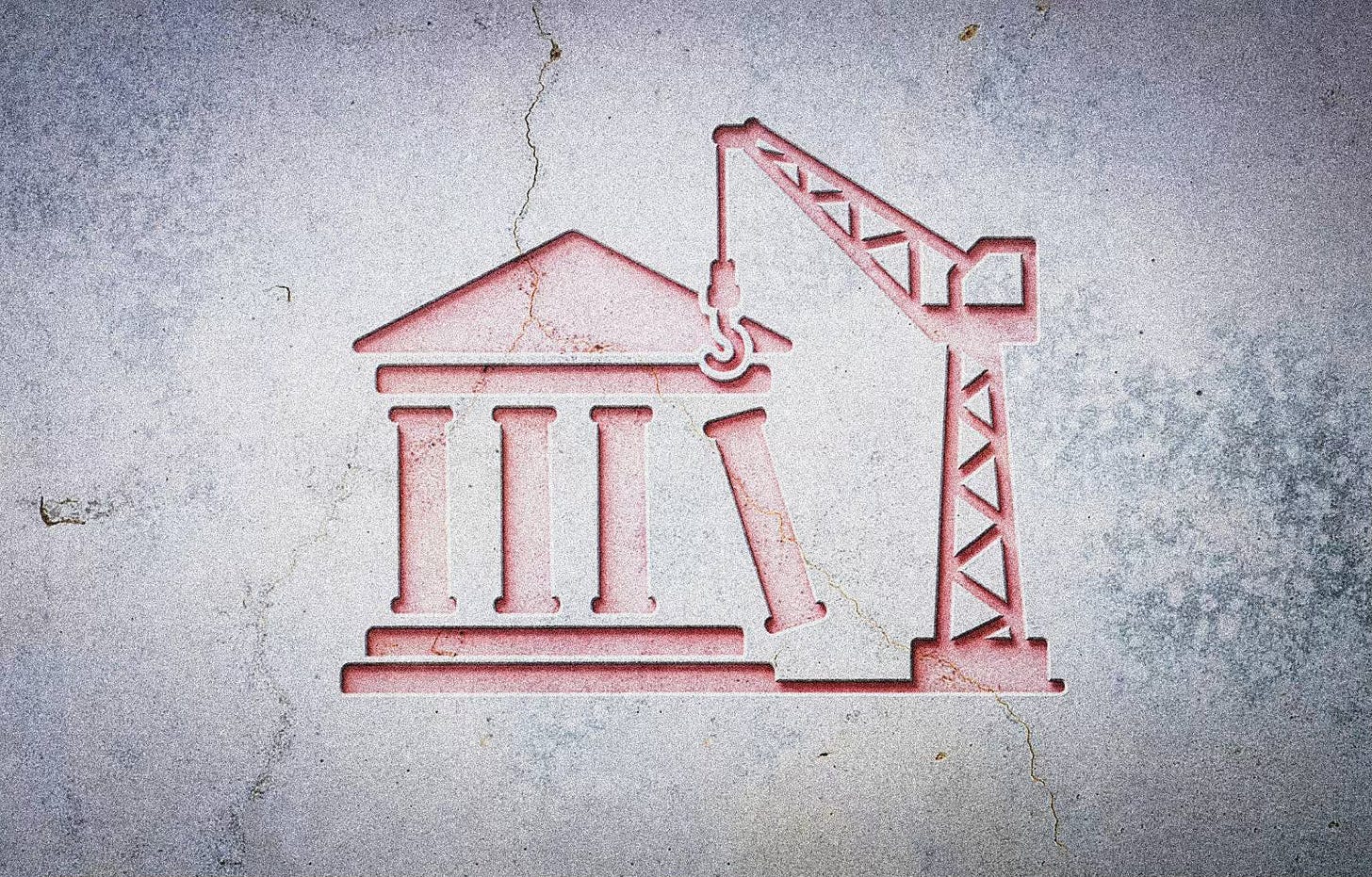Introducing: The Reconstruction Agenda
Liberals need to start planning for a post-authoritarian future and rebuilding stronger institutions that a rogue president can’t so easily take over and weaponize again
Free societies have always struggled to keep from undoing themselves. From Rome’s drift into empire to the English Parliament’s fight against royal prerogative, from the city states of Renaissance Italy to the Weimar Republic, the pattern is familiar: concentrated power overwhelms the rules meant to contain it. Republics seldom fall to invasion; they erode from within, one emergency at a time.
America’s version of that story has been playing out, with distinctly American twists for the era of TV and social media, fittingly led by, of all people, a game show host. Still, the presidency has swollen into a near-monarchy, a turnkey tyranny, now in the hands of a rapidly consolidating authoritarian regime. Congress has become a theater of the absurd, stripped of all meaningful power, its laws and spending decisions nullified on a whim. The courts are now the ultimate political prize, a means of entrenching partisan policy preferences in perpetuity. Each election feels existential because, increasingly, it is.
The Reconstruction Agenda, a new project of The UnPopulist, will take this problem seriously, building on its Fireproofing the Presidency series. Its Executive Watch project is diligently documenting the copious abuses of the office emanating from this White House. The Reconstruction Agenda will propose fixes and mechanisms to avoid such a scenario from transpiring ever again. Through written analysis from myself and outside experts, along with regular in-depth interviews on The Reconstruction podcast, it will examine how American democracy became so brittle and how it might be rebuilt. The goal is to value genuine expertise and make it accessible to any thoughtful reader. You’re smart people and you deserve smart answers, not clickbait and ill-informed punditry, nor nihilistic doomerism. The task before us is restoring the capacity for freedom and self-government, not simply lamenting its decline.
The Architecture of Failure
The imperial presidency wasn’t invented; it accumulated, until finally the last guardrails broke in the form of an autocrat as shameless as he is lawless. Each crisis expanded executive power, each function ceded by Congress became precedent. The Supreme Court, now dominated by a kind of presidential absolutism masquerading as originalism, has propounded new doctrines that would horrify the Framers, from presidential immunity to some rather extreme versions of unitary executive theory. The modest chief magistrate the Constitution envisioned has become the center of national life, the constant main character at the center of everything, a universe revolving around the occupant of the Oval Office.
Congress’s decline is the mirror image. Legislators act more as commentators than as lawmakers. Oversight is theater; building consensus is treated as betrayal. The modern political marketplace rewards outrage, not results. Lawmaking, negotiation, and budgeting—the core tasks of republican government—have been displaced by spectacle. The people’s branch has turned itself into an impotent sideshow, a Roman Senate pretending it still has a purpose in the shadow of Caesars.
The judiciary now doubles as policymaker, pursuing an agenda radically at odds with the system of checks and balances the justices profess to uphold, subverting limits on both their own power and the president’s. When every policy question ends up in court, and when the administration is little more than a crime spree, law becomes politics by other means. The Supreme Court was never meant to be the country’s only functioning legislature, much less to give an illicit impunity to the man who would be king by handing him sweeping immunity for “official” acts whose understanding is astonishingly broad.
Even the democratic machinery has warped. Gerrymandering, single-member districts, and America’s uniquely absolute and entrenched two-party system distort representation, empowering narrow factions and illiberal extremism. Habit and inertia keep the system running, but the incentives all point toward dysfunction. The more broken it gets, the harder it becomes to repair.
A New Birth of Freedom
The Constitution was an attempt to solve the oldest political problem: how to make liberty durable by making power difficult. A system of government both sufficient to keep order, but not so overbearing it snuffs out the rights of the people. The principles behind its design—divided authority, overlapping ambitions—was drawn from centuries of failed experiments. It was also intended to adapt, to learn, to be amended as needed. Repairing it requires neither blind nostalgia nor total repudiation, just the will to use it as intended.
That means Congress must once again legislate. It should begin by reclaiming its war powers, reasserting the power of the purse, repudiating Trump’s usurpation of control over public spending, and exercising real oversight over an administration in which corruption has run rampant. And the full diversity of the American people must be represented, not just two homogenized blobs answering to only a tiny fraction of the electorate in partisan primaries and uncompetitive districts. A legislature that embodies a truly representative government remains the surest check on democratic backsliding. Trump, after all, has never won over 50% of the popular vote, and his approval ratings and diehard base are much smaller than that. Our electoral system has given us, in effect, a government of minority rule.
The presidency should shrink back to constitutional scale, and perhaps be fundamentally restructured. Emergency powers must expire unless renewed by Congress. Executive orders should implement laws, not invent them. Government agencies must answer to elected lawmakers, not presidential decrees.
The courts need both reform and turnover. Fixed terms for Supreme Court justices would lower the stakes of each appointment, and the idea has cross-ideological support, so it at least ought to be debated and discussed along with other bolder solutions. A restrained judicial philosophy—more assertive in enforcing individual rights, and much less determined to empower the presidency over Congress—would preserve ideological balance and improve the Court’s vastly eroded public legitimacy.
And the foundations of democracy need both protection from novel threats and a thorough modernization, including moving away from winner-take-all systems. Elections are the most fundamental framework of our political incentives, and nothing else survives when that shared premise collapses. A democracy can handle disagreement; it cannot survive a system where losing feels illegitimate and the winners can use unlimited power to stifle opposition.
The first Reconstruction rebuilt freedom and citizenship after the Civil War—imperfectly, to be sure. The commitment faded and with it large parts of the country descended into another century of tyranny. But the embers of Reconstruction did not fully die out. The 13th, 14th, and 15th Amendments—eradicating slavery, promising due process and equal protection under the law while also enshrining guaranteed citizenship, and expanding suffrage respectively—lay effectively dormant but were not forgotten, and in the end their promises—and Lincoln’s “new birth of freedom”—triumphed.
After other moments of constitutional tension, we’ve reformed our institutions accordingly. Adopting term limits after FDR broke the norm of a two-term president, and post-Watergate reforms to rein in Nixon’s executive abuses, among others. This is the business of self-government at its core. A system that can’t bend and adapt to changing circumstances will eventually break.
Donald Trump will not be in power forever, and neither will his enablers and co-conspirators. In the aftermath of such a dramatic constitutional collapse, there must be accountability, but there must also be rebuilding. Balancing those two goals will shape our future for years to come. And how we think about those problems now will inform the best strategies for fighting back in defense of the best in the American tradition.
More fundamentally, no parchment barriers can save a people who are not committed to the fundamental principles of freedom, equality, and democracy. America’s heritage is embodied in these foundational liberal ideals, but they must be articulated and revived for each new generation. We are fortunate that we have a deep cultural aversion to autocracy. That must not be allowed to atrophy. Indeed, we need to re-learn how to use that reflex when it is needed most, which is now. Institutional reforms can only flow from such a deeper commitment.
The Reconstruction Agenda will chart that task—diagnosing the structural failures of the past and mapping the reforms necessary for a durable liberal democracy.
© The UnPopulist, 2025
Follow us on Bluesky, Threads, YouTube, TikTok, Facebook, Instagram, and X.
We welcome your reactions and replies. Please adhere to our comments policy.








I think a useful first step that doesn’t require a Constitutional amendment would be amending the Reapportionment Act of 1929 that capped the House of Representatives at 435 when our country had “only” 106 million people. Today we have 347 million. Having more representatives would bring them back to a much closer relationship to their constituents. It would also give more populated areas more voice than they currently have compared with the power of the rural vote, which is why I’m sure this will be controversial.
Can someone point out to me the passage in the Constitution that gives a single man the power to keep the people's House out of session indefinitely for his own political ends?